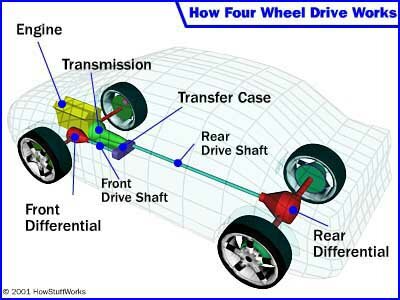What’s the Difference between All Wheel Dive, 4 Wheel Drive, Rear Wheel Drive, and Front Wheel Drive?
The basic layout of a vehicle's powertrain includes an engine, transmission, and a driveshaft. There are four variations of how those components are laid out: rear-wheel drive (RWD), front-wheel drive (FWD), all-wheel drive (AWD), and four-wheel drive (4WD/4X4).
Rear-wheel drive is the oldest layout of the drivetrain, as its design is quite simple. The classic layout of RWD includes the engine in the front, sending power through the transmission and driveshaft to the differential, which sends power to the wheel with the most traction through a set of gears or through both wheels if traction is equal. Rear-wheel drive provides oversteer, which kicks the rear end out, and the front end into where the driver is turning. If a car has enough power, they are able to drift the vehicle by losing traction in the rear, enabling the vehicle to go sideways through a corner.
Most cars produced today are made with a front-wheel-drive setup, which has the engine in the front, sending power to the front wheels only. The powertrain is sideways with the transmission sitting directly on top of the differential, which sends power to the wheels. Since this layout is so compact, it is cheaper to produce, hence the reason why most cars today are made in this platform. Front-wheel drive vehicles are more prone to understeer where the vehicle tends to go straight instead of the direction in which the driver is pointing the vehicle. Drifting is possible only through the use of the handbrake/emergency brake, which breaks traction in the rear wheels.
 All-wheel drive and four-wheel drive is a combination of FWD and RWD, so the car sends power to both the front and rear wheels. The way that the cars send power to all of the wheels is different, though. In a 4WD platform, the car, or in most cases a truck or SUV, sends power to the rear wheels like a RWD car but with the push of a button or lever the car, through a transfer case, can send power to all four wheels, which is optimal for off-road conditions. In an AWD platform, the car has a center differential that sends power to all wheels all of the time.
All-wheel drive and four-wheel drive is a combination of FWD and RWD, so the car sends power to both the front and rear wheels. The way that the cars send power to all of the wheels is different, though. In a 4WD platform, the car, or in most cases a truck or SUV, sends power to the rear wheels like a RWD car but with the push of a button or lever the car, through a transfer case, can send power to all four wheels, which is optimal for off-road conditions. In an AWD platform, the car has a center differential that sends power to all wheels all of the time.
 Personally, I like RWD platform cars because of their sportiness and overall better handling and turning abilities. RWD cars are the classic version of the sports car, so I like the history behind it and the iconic feeling of it.
Personally, I like RWD platform cars because of their sportiness and overall better handling and turning abilities. RWD cars are the classic version of the sports car, so I like the history behind it and the iconic feeling of it.
Rear-wheel drive is the oldest layout of the drivetrain, as its design is quite simple. The classic layout of RWD includes the engine in the front, sending power through the transmission and driveshaft to the differential, which sends power to the wheel with the most traction through a set of gears or through both wheels if traction is equal. Rear-wheel drive provides oversteer, which kicks the rear end out, and the front end into where the driver is turning. If a car has enough power, they are able to drift the vehicle by losing traction in the rear, enabling the vehicle to go sideways through a corner.
Most cars produced today are made with a front-wheel-drive setup, which has the engine in the front, sending power to the front wheels only. The powertrain is sideways with the transmission sitting directly on top of the differential, which sends power to the wheels. Since this layout is so compact, it is cheaper to produce, hence the reason why most cars today are made in this platform. Front-wheel drive vehicles are more prone to understeer where the vehicle tends to go straight instead of the direction in which the driver is pointing the vehicle. Drifting is possible only through the use of the handbrake/emergency brake, which breaks traction in the rear wheels.






Comments
Post a Comment